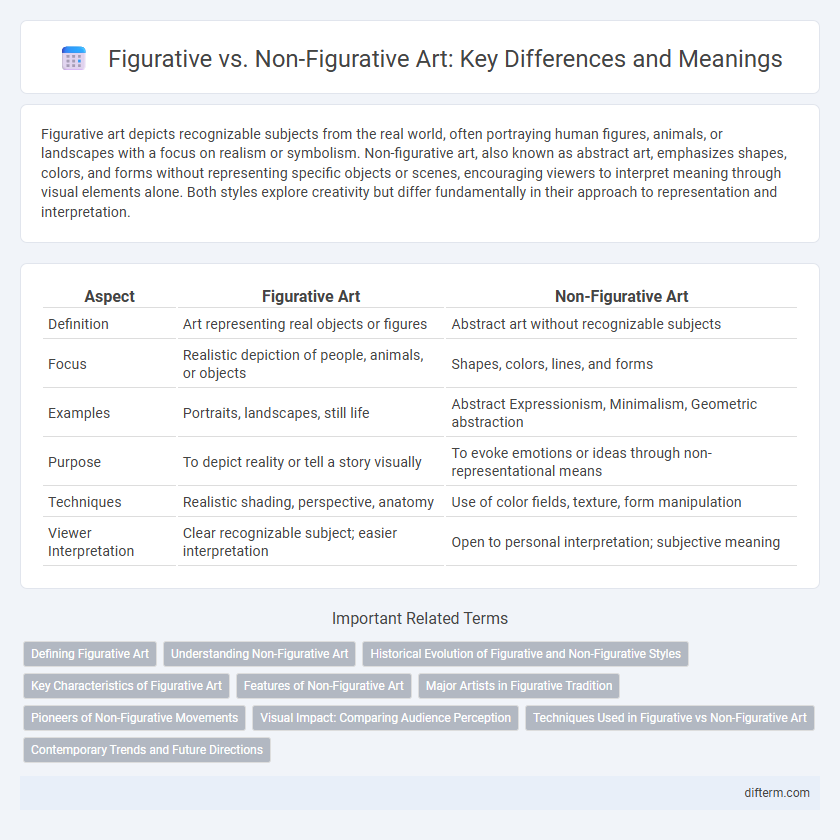Figurative art depicts recognizable subjects from the real world, often portraying human figures, animals, or landscapes with a focus on realism or symbolism. Non-figurative art, also known as abstract art, emphasizes shapes, colors, and forms without representing specific objects or scenes, encouraging viewers to interpret meaning through visual elements alone. Both styles explore creativity but differ fundamentally in their approach to representation and interpretation.
Table of Comparison
| Aspect | Figurative Art | Non-Figurative Art |
|---|---|---|
| Definition | Art representing real objects or figures | Abstract art without recognizable subjects |
| Focus | Realistic depiction of people, animals, or objects | Shapes, colors, lines, and forms |
| Examples | Portraits, landscapes, still life | Abstract Expressionism, Minimalism, Geometric abstraction |
| Purpose | To depict reality or tell a story visually | To evoke emotions or ideas through non-representational means |
| Techniques | Realistic shading, perspective, anatomy | Use of color fields, texture, form manipulation |
| Viewer Interpretation | Clear recognizable subject; easier interpretation | Open to personal interpretation; subjective meaning |
Defining Figurative Art
Figurative art represents real-world objects, particularly human figures, using recognizable shapes and forms that convey clear subjects, emotions, and narratives. This artistic style emphasizes lifelike representation and often explores anatomy, expression, and realistic detail to communicate meaning. Figurative art contrasts with non-figurative art, which relies on abstraction without depicting identifiable subjects.
Understanding Non-Figurative Art
Non-figurative art, also known as abstract art, departs from representing real-world objects, emphasizing shapes, colors, and forms to evoke emotions and ideas without direct visual references. This genre challenges traditional perspectives by encouraging viewers to interpret artworks through personal experience rather than recognizing familiar subjects. Key artists like Wassily Kandinsky and Piet Mondrian pioneered this movement, highlighting the significance of pure artistic elements in conveying meaning.
Historical Evolution of Figurative and Non-Figurative Styles
Figurative art, rooted in ancient civilizations, emphasizes realistic representation of the human form and natural objects, evolving through classical, Renaissance, and Baroque periods with increasing anatomical precision and narrative complexity. Non-figurative art emerged prominently in the early 20th century, driven by movements like Cubism, Abstract Expressionism, and Suprematism, focusing on symbolic, geometric, and emotive expressions detached from recognizable subjects. The historical evolution showcases a dialectic shift from mimetic representation to abstraction, reflecting broader cultural, philosophical, and technological changes in artistic practice.
Key Characteristics of Figurative Art
Figurative art primarily represents real objects or human figures, emphasizing accurate and recognizable forms to convey narrative or emotion. It often relies on traditional techniques such as perspective, proportion, and detailed anatomy to create lifelike depictions. This genre typically explores themes rooted in everyday life, history, mythology, and personal identity, enabling viewers to connect with familiar visual references.
Features of Non-Figurative Art
Non-figurative art emphasizes abstract forms, colors, and shapes without representing recognizable objects or figures, prioritizing emotional expression and visual impact over realistic depiction. This style often explores texture, composition, and the interplay of lines and spaces to create meaning independent of literal imagery. It challenges viewers to interpret art through personal perception and subjective experience rather than through identifiable subjects.
Major Artists in Figurative Tradition
Major artists in the figurative tradition include Lucian Freud, known for his psychologically intense portraits, and Alice Neel, whose expressive depictions of human subjects emphasize emotion and character. Francis Bacon also stands out for his distorted yet recognizable figures that explore human vulnerability and existential themes. These artists maintain a strong connection to representational form while innovating within the boundaries of figurative art.
Pioneers of Non-Figurative Movements
Wassily Kandinsky and Kazimir Malevich are recognized as pioneering figures in the development of non-figurative art, breaking from traditional representation to explore abstraction and pure form. Their works, such as Kandinsky's "Composition VII" and Malevich's "Black Square," challenged conventional aesthetics by emphasizing color, shape, and emotion over recognizable subjects. These artists laid the foundation for later abstract movements, influencing generations of painters to prioritize conceptual expression over figurative depiction.
Visual Impact: Comparing Audience Perception
Figurative art, characterized by recognizable subjects and realistic representations, often evokes emotional connections through identifiable imagery that resonates with viewers' experiences. Non-figurative art, or abstract art, relies on color, form, and texture to elicit responses, encouraging audiences to interpret meaning based on personal perception and emotion. The visual impact between these styles differs as figurative art anchors understanding in familiar visuals, while non-figurative art stimulates cognitive engagement by challenging traditional representation.
Techniques Used in Figurative vs Non-Figurative Art
Figurative art techniques emphasize realistic representation through methods like chiaroscuro, perspective, and anatomical accuracy to depict recognizable subjects. Non-figurative art employs abstract techniques such as color field application, gestural brushstrokes, and textural layering to evoke emotion without direct reference to reality. Each approach utilizes distinct artistic methods to convey meaning, either through depiction or abstraction.
Contemporary Trends and Future Directions
Contemporary trends in art reveal a dynamic interplay between figurative and non-figurative styles, with artists increasingly blending realistic human forms with abstract elements to explore identity and emotion. The future direction points toward immersive digital media and virtual reality, offering novel ways to reinterpret both figurative representation and non-figurative abstraction. This evolution emphasizes personalized experience, challenging traditional boundaries and expanding the semantic possibilities of visual language.
Figurative vs Non-Figurative Infographic

 difterm.com
difterm.com